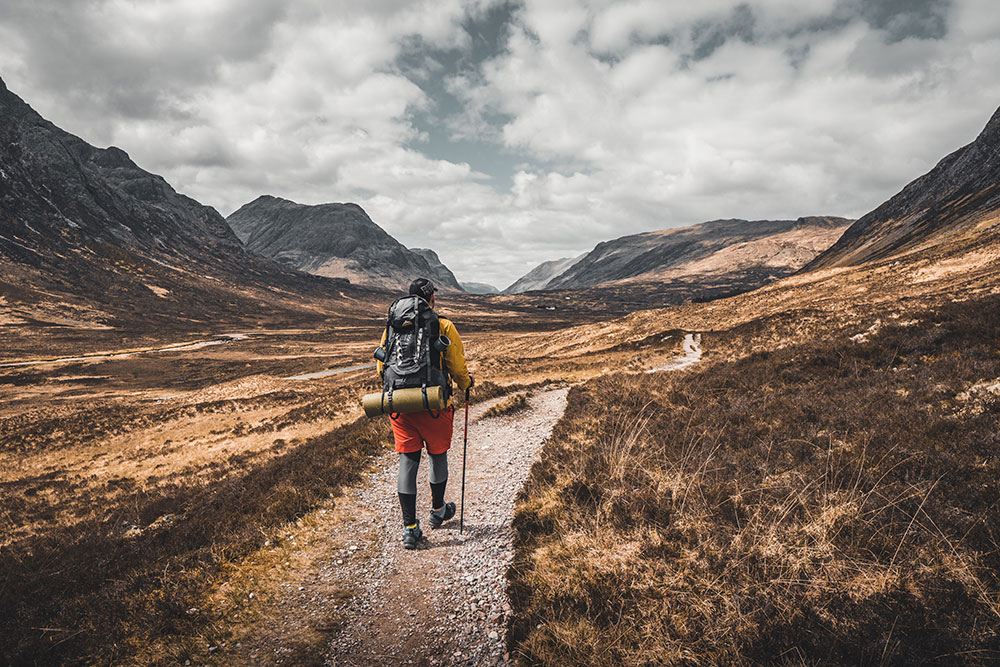Walking holidays are a great way to see beautiful scenery, get fit and enjoy the benefits of spending time in nature. Whether you’re walking long-distance or just hiking for a day, it’s important to take care of your knees as these are the joints which carry most of your weight.
In this article, our osteopath Tom Ward explains how your knee joints are supported and stabilised by your muscles and other joints, and offers some helpful tips to prevent knee injury.
How is your knee joint supported?
Your knee joints are supported by the muscles, tendons and ligaments in your legs and feet. To prevent knee injury when hiking, it’s important to strengthen those areas so they can take the weight of you and your backpack.
Additionally, your core muscles like your glutes and hip muscles stabilise your pelvis so that your femur (that’s your large thigh bone) can extend your hip with ease. If your core is not strong enough, your pelvis will tilt to compensate. This will affect how your femur aligns, which in turn affects the positioning of your knee joint.
Your osteopath can help prevent knee injury
Owner of our Epsom clinic, osteopath Tom Ward specialises in treating sportspeople and athletes.
Tom says “I see a huge number of patients experiencing knee pain after walking which can impact both their confidence and their love for exercise. That is why is it is so important to move and stretch the around the knees after walking but also to seek expert advice when you are struggling to get you up and moving as quickly as possible.”
Exercises to support your knee joints
With the knowledge of how your knee joints work with the surrounding muscles and joints, our osteopaths can design a tailored exercise program to prevent knee injury, or help you heal knee pain.
Here are two simple exercises you can try at home, which will build strength and provide stability for your knee joints.
- Clamshell exercise
Lay on your side, with your knees bent 30 degrees and your ankles stacked over each other. Raise your top knee away from your bottom knee, while keeping your hips absolutely still, to work the right muscles around your core, hips and thighs. - Bridge
Lay on your back and bend your knees so that your feet are flat on the floor and close to your buttocks. Contract your core, squeeze your buttocks, and lift your hips up off the ground so that your knees, hips and shoulders are in a straight line. Focus on keeping your hips level with each other, as you lift them.
Prevent knee injury when walking uphill
For most of us, our hamstrings, glutes and calf muscles are weaker than the muscles in the front of our body (like the quadriceps and hip flexors). When we rely too much on those front muscles our knees track too far forward, over our ankles. This creates wear and tear in the knee cartilage, over time.
To sort this out, try keeping your knee and shin vertical to the ground as you hike uphill, using your calf muscles instead of your quadriceps. You’ll find you can do this if you keep your foot flat on the ground as you walk – so rather than stepping with your toe, include your heel in each step forward.
How to prevent knee injury when walking downhill
Even if you’re lucky enough to have joints that work well, long steep descents on a walking holiday are common causes of knee pain.
To support your knee joints when walking downhill, shift your weight back and let your hips gently sway from side to side. This will spread the load so your knees don’t take the full force with each step. Try trekking poles to reduce knee pain and consider zig-zagging down a steep path so you avoid walking downhill on extended legs, which will create a more painful impact on your knees.
Book your appointment with Tom today, via our webpage.


